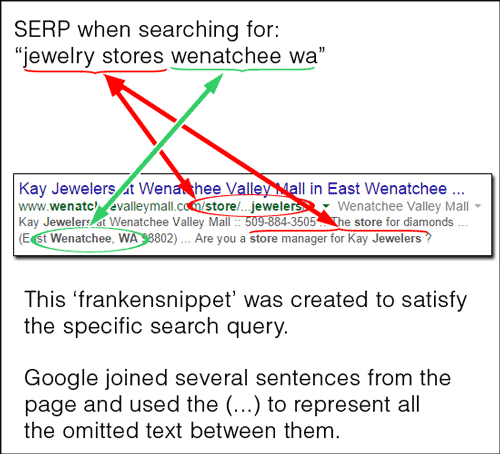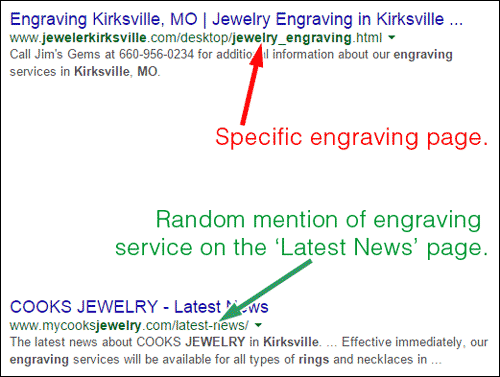
The ellipses are a set of three periods that has different functions depending on how that punctuation is used.
In these Daily Golden Nuggets, I often use this symbol to represent a long pause or a trailing off thought. In text messages, I use them to represent long pauses, or sometimes I even send them alone in a single text message to illustrate a perplexed reaction when I don't know what to say. A stunned silence, perhaps.
The ellipses has turned into one of the most commonly used punctuations in instant communication methods, a phenomenon that some people are trying to explain.
Using ... in SEO
Meanwhile, back at Google and Bing, they have been using the ellipses in the search engine optimization process for many years, and they've been using it correctly.
Do a random search for any keyword and you're bound to see a mixture of results with easy to understand descriptions and a few descriptions that look like they were stitched together to force a result.
Take a look at this example:

That was among the results returned when searching for "jewelry stores wenatchee wa." Google tried really hard to make this work, but I classify it as a failure, mainly because of the sentence that reads "Are you a store manager for Kay Jewelers?"
In the absence of perfectly formatted meta descriptions, Google created ‘Franken-Snippets*’ like this by joining several sentences from the page but uses the (...) to represent all the omitted text between those sentences.
Google will join the URL, header text, footer text, and nonsense sentences from the page to force a search results match.
Take another look at that example to see how it matches up:

Avoiding the Automatic ... in Snippets
For optimal SEO you should be writing a 150 character description, including spaces, for every page of your website. If it seems impossible to write such a terse description, then you've probably included too many topics on the page.
When building the pages on your website, you should always limit every page to a single topic. A good example of an incorrect, multi-topic page is the Services Page that most jewelers have on their website. This page typically lists services like jewelry repair, watch repair, pearl restringing, custom design, and engraving. A page like that, with five different topics, is difficult to explain in 150 characters except to say "these are all the services we provide."
Unfortunately, Google and Bing will ignore your meta description when matching that page with one of those specific services. Someone searching for "engraving" will probably see a Franken-Snippet created from the brief description you wrote for your engraving service.
Will that services page be highly ranked in the SERPs? It all depends if your local competitors are also using multi-purpose services pages, or if they have dedicated pages for each service.
If you are using one of the Signature Engraving Systems in your store, you probably want to have the best chance of capturing as many engraving sales as possible. After all, those machines need to be paid for.
So why not set up a dedicated page for that single topic like you see here:

In that above example, instead of seeing a random auto-generated snippet, we see the actually meta description written for that page: "Call Jim's Gems at 660-956-0234 for additional information about our engraving services in Kirksville, MO."
Although it's a simple meta description, Google didn't see any need to expand upon it.
So the best way to avoid the snippet (...), and the creation of the Franken-Snippet all together, is to create dedicated pages for single topics that can then be described in 150 characters or less meta descriptions that you add to the SEO settings of every page.
Google Knowledge Graph and ... Usage
When was the last time you used Google as an answer engine and didn't even bother clicking any of the pages that appeared in the SERP?
Google has a growing system they refer to as the Knowledge Graph which tries to pull in direct answers from reputable online sources. Those answers usually appear in boxes (called cards) at the top of the SERP.
In the absence of specific cards, Google will simply list search results with full sentence snippets that they carved from the page.
I'm bringing this up now because many jewelry stores have educational information on their sites. Whenever possible, boil down an entire page of educational information to a 140 character description followed by ", more..." at the end.
In this scenario, you are introducing your own (...) in the meta description as a way to entice users to click to find out more information. This little usability trick burns up 9 of those precious 150 characters you have for the meta description, but it builds website traffic when the description is well written.
*The term "Franken-Snippets" was introduced to me at an official Google training class in New York City some years ago. You won't find the term written about in any official Google blog and other SEO bloggers rarely mention it too, but it is a real thing.








